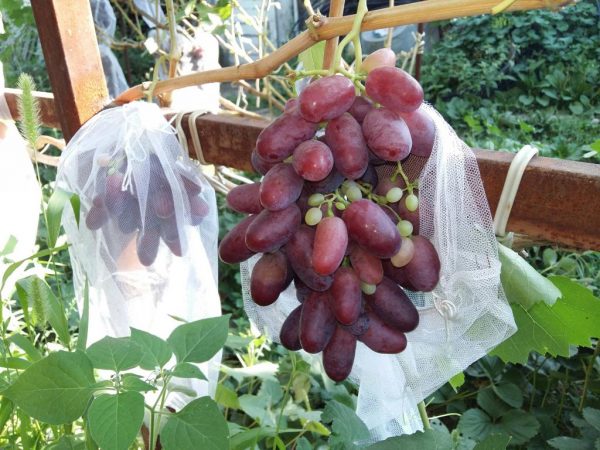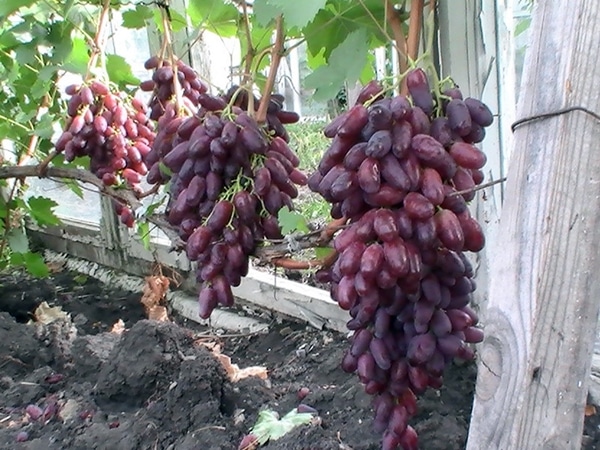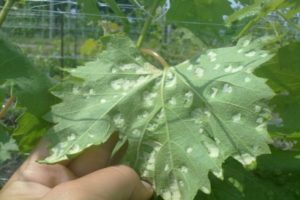Description of the Rizamat grape variety, yield characteristics and cultivation technology
Among the many varieties of grapes, the Rizamat variety is valued for its taste characteristics and stable fruiting. The berry is suitable for growing in small suburban areas or on an industrial scale. Having planned the planting of this variety, it is recommended to familiarize yourself in advance with the peculiarities of caring for the vines in order to get a large harvest.
Breeding history
The Rizamat variety was bred in Uzbekistan by amateur breeders. It was possible to create a table-raisin variety by crossing the Parkent and Kattakurgan varieties.
Description of the variety
The hybrid variety belongs to the early maturing category. Rizamata bushes are thickened, with leaves of medium size and five-lobed shape. The conical bunches grow to large sizes and weigh from 600 g to 1 kg.
One ripe berry reaches a mass of 9 to 14 g. The shape is oblong-oval. There is a slight waxy bloom on the surface of the berries. The skin is thin and covers the juicy and firm flesh. According to the description of the variety, the sugar content is 18-22%.

Variety characteristics
The Rizamat grape has a number of distinctive characteristics. These include the following:
- Harvest versatility. Berries are suitable for fresh consumption, juicing and wine making, storage.
- Frost resistance. When using a covering material, the crop is resistant to frost and temperature changes.
- Harmonious taste. Thanks to the optimal ratio of acids and sugars in the composition, the grapes get a sweet taste.
Basic landing rules
The key to growing a quality crop is proper planting. The soil on the site for planting grapes must be constantly illuminated and protected from blowing through. For intensive growth in the soil, the presence of nutrients is required. Having chosen a suitable place and proceeding to the direct disembarkation, the following rules must be taken into account:
- at the bottom of the planting pit, a drainage layer about 3 cm thick, a layer of fertilizers and nutritious soil are arranged;
- it is better to transfer seedlings to open soil in spring, after the likelihood of recurrent frosts disappears;
- the seedlings should be free from signs of infection or harmful insects.

Care
The vines are demanding to care for and are not able to bear fruit intensively when grown in the wild. Basic plant care involves watering, fertilizing, crown formation and protection from negative external influences.
Watering
The soil on which the Rizamat grapes are planted must be constantly moistened. Abundant watering is especially required during the flowering period and during the formation of the first berries on the bunches.
Do not pour water under the bush.
It is necessary to dig irrigation holes or make depressions in the ground, which, after irrigation, are sprinkled with earth and a layer of mulch. For mulching, sawdust or moss are suitable.
Pruning
The formation of bushes by removing stepchildren, pruning dried leaves and branches is necessary to give the plants a neat shape and active fruiting. The thinned crown is better ventilated, and more sunlight penetrates to the bunches.
Removing excess vegetation reduces the risk of diseases affecting bushes and favorably affects the quality of the crop.
Preparing for winter
After all the leaves have fallen in the fall, the grape bushes protect against the coming winter frosts. In the northern regions, the bushes should be completely covered using film or burlap. In the absence of extremely low temperatures, it is sufficient to cover only the area around the vineyard roots.

Advantages and disadvantages of the variety
The main advantages of Rizamata are taste, early ripening and stable fruiting with proper care. In addition to the obvious positive characteristics, there are several disadvantages that can be encountered when growing grapes. In the case of a sharp change in soil moisture, cracks may appear on the berries, and if the bushes are affected by diseases, there is a risk of a decrease in yield.
Disease protection
Rizamat is characterized by diseases of oidium, anthracnose and apoplexy. To protect plants from infections, it is necessary to carry out chemical treatment three times per season for preventive purposes. The bushes should be sprayed before flowering and during the formation of berries. To protect against diseases and repel pests, the preparations "Storby" and "Kuproskat", a solution of Bordeaux liquid, and other agents from the category of fungicides are suitable.








